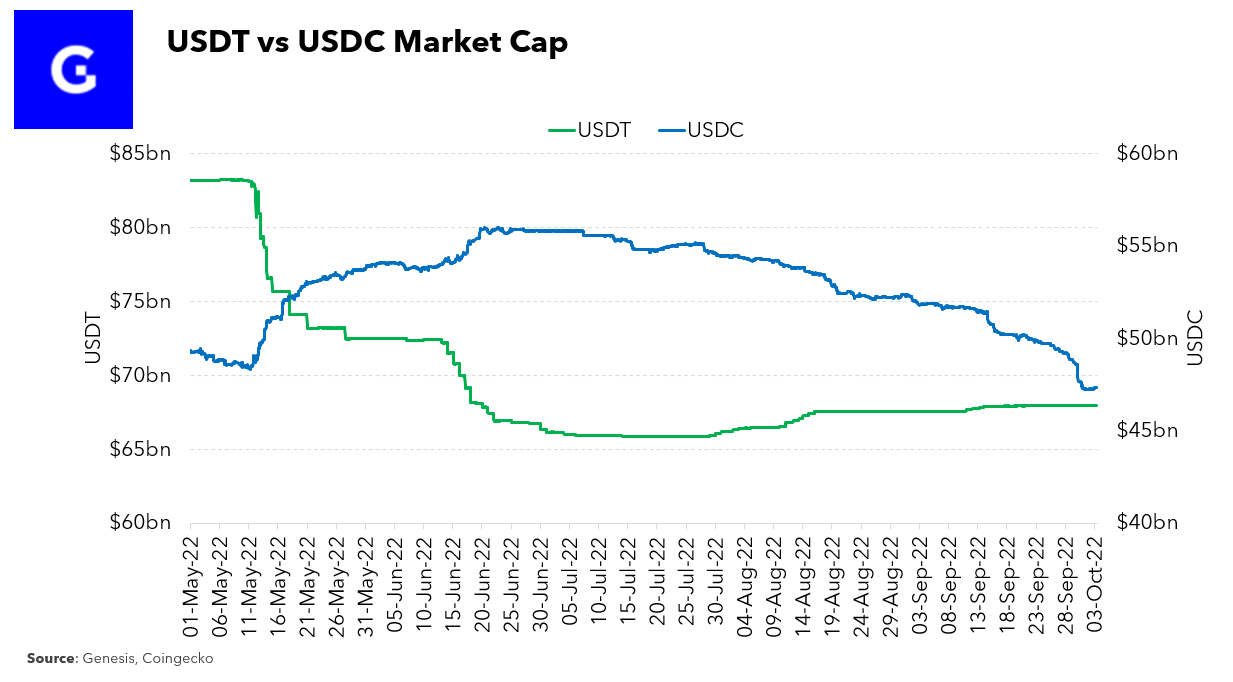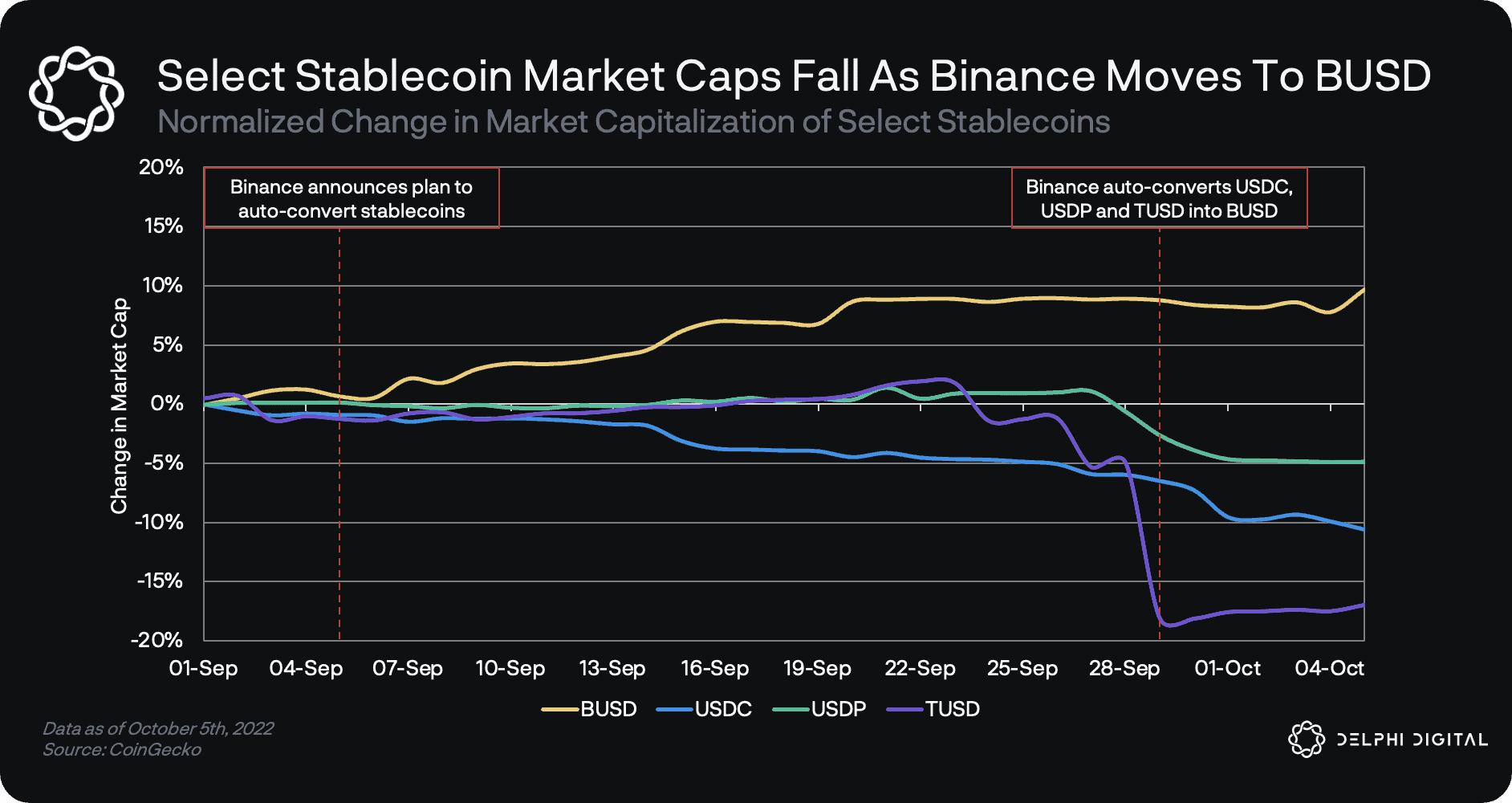Circle’s dollar-pegged stablecoin USD coin (USDC) has returned to earth after seeing impressive growth following the collapse of Terra in May.
The stablecoin’s market value has dropped by $10 billion to $46 billion in three months, hitting the lowest since January, according to data source CoinGecko. The decline has more than reversed the rise from $48 billion to $56 billion seen after Terra’s algorithmic stablecoin UST went bust, sparking redemptions in tether (USDT), the world’s largest stablecoin.
USDC appears to have lost market share to rivals Binance USD (BUSD), the world’s third-largest stablecoin and tether. Since early July, BUSD’s market value has increased by 21% to $21.66 billion and tether’s has gone up by 3% to $68.3 billion.
According to industry experts, several factors, including stability in USDT, Tornado Cash sanctions and Binance’s recent decision to consolidate order books, are responsible for USDC’s dwindling market capitalization.
“After Terra collapsed, there was a strong move to sell USDT and shift to quality, USDC, perpetuated by concerns that USDT was also heading to $0,” Wes Hansen, director of trading and operations at Arca, said. “However, once the fears of USDT collapse subsided, investors began returning to stablecoins with the best market depth, which is usually USDT on non-U.S. exchanges.”
Hansen added that investors concerned with U.S. regulators prefer USDT to USDC and could be moving back to USDT.

USDT is slowly regaining its market share lost mainly to USDC following Terra’s collapse. (Genesis, CoinGecko)
USDC’s safe haven appeal stems from the transparency of its reserves and due to its issuance being regulated in accordance with U.S. state money transmission supervision. On the contrary, tether’s reputation has been long marred by controversy surrounding the nature of its reserves.
Nevertheless, tether withstood the market’s stress test following Terra’s collapse, with the issuing company honoring redemptions worth billions of dollars. While the stablecoin’s peg broke and the price fell as low as 92 cents on some exchanges in the aftermath of the Terra crash, the volatility was short-lived. The stablecoin averaged about 99 cents in June and regained a stable dollar peg in July.
Amey Dandawate, a research analyst at Delphi Digital, said the drop in USDC’s market supply could be attributed to crypto exchange Binance’s decision to remove the stablecoin as a tradeable coin on its platform. With an average daily volume of $20 billion, Binance is the world’s largest cryptocurrency exchange.

Market cap of USDC declines as Binance consolidates order books (Delphi Digital)
On Sept. 5, Binance announced that it would convert all investments in USDC, pax dollar (USDP) and trueUSD (TUSD) into BUSD, suspending spot, future and margin trading in the three stablecoins. Since then, USDC’s market cap has dropped by nearly $5 billion while BUSD’s market value has risen by over $2 billion.
“Users can still deposit or withdraw these stablecoins, but they will be converted to BUSD for use on the exchange,” Dandawate said in a note to clients. “While combining different stablecoins into one enhances liquidity and capital efficiency for traders, it also helps Binance increase the usage of its native BUSD stablecoin over others.”
Lastly, Circle’s decision to freeze USDC addresses associated with the blacklisted crypto mixer Tornado Cash may have contributed to USDC’s market cap decline.
On Aug. 8, the U.S. Department of the Treasury’s Office of Foreign Assets Control (OFAC) sanctioned virtual currency mixer Tornado Cash, saying the application has been used to launder $7 billion worth of virtual currency since its inception in 2019.
Circle immediately froze over 75,000 USDC linked to the 44 Tornado Cash addresses in a tell-tale sign that other stablecoins like USDT, which remain non compliant, may be better at preserving investor privacy.
“About $4 billion in USDC left the Ethereum ecosystem since the Tornado cash sanctions announced on Aug. 8, and USDC market share on Ethereum has declined by roughly 3%,” Dustin Teander, research analyst at Messari, told CoinDesk in an email.
However, all is not lost for USDC, which remains a dominant force in decentralized finance (DeFi).
“BUSD has seldom been used in DeFi and is not near the top 10 pools of Curve, Uniswap, Aave etc. USDC usage, however, remains strong. Four of the top five Uniswap pools contain USDC,” Teander said. “Over the last seven days, USDC pools, compared, have accounted for over 50% of the swaps, 77% of the volume, and 63% of the fees generated of the top Uniswap V3 pools.”
And while tether seems to have gained ground, its market cap remains well below the high of $89 billion seen ahead of Terra’s crash and concerns about its reserves linger.







